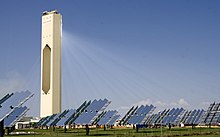Development, deployment and economics
Main article: Deployment of solar power to energy grids
See also: Cost of electricity by source
Beginning with the surge in coal use which accompanied the Industrial Revolution, energy consumption has steadily transitioned from wood and biomass to fossil fuels. The early development of solar technologies starting in the 1860s was driven by an expectation that coal would soon become scarce. However development of solar technologies stagnated in the early 20th century in the face of the increasing availability, economy, and utility of coal and petroleum.[104]
The 1973 oil embargo and 1979 energy crisis caused a reorganization of energy policies around the world and brought renewed attention to developing solar technologies.[105][106] Deployment strategies focused on incentive programs such as the Federal Photovoltaic Utilization Program in the US and the Sunshine Program in Japan. Other efforts included the formation of research facilities in the US (SERI, now NREL), Japan (NEDO), and Germany (Fraunhofer Institute for Solar Energy Systems ISE).[107]
Commercial solar water heaters began appearing in the United States in the 1890s.[108] These systems saw increasing use until the 1920s but were gradually replaced by cheaper and more reliable heating fuels.[109] As with photovoltaics, solar water heating attracted renewed attention as a result of the oil crises in the 1970s but interest subsided in the 1980s due to falling petroleum prices. Development in the solar water heating sector progressed steadily throughout the 1990s and growth rates have averaged 20% per year since 1999.[39] Although generally underestimated, solar water heating and cooling is by far the most widely deployed solar technology with an estimated capacity of 154 GW as of 2007.[39]




 We have always used the energy of the sun as far back as humans have existed on this planet. As far back as 5,000 years ago, people "worshipped" the sun. Ra, the sun-god, who was considered the first king of Egypt. In Mesopotamia, the sun-god Shamash was a major deity and was equated with justice. In Greece there were two sun deities, Apollo and Helios. The influence of the sun also appears in other religions – Zoroastrianism, Mithraism, Roman religion, Hinduism, Buddhism, the Druids of England, the Aztecs of Mexico, the Incas of Peru, and many Native American tribes.
We have always used the energy of the sun as far back as humans have existed on this planet. As far back as 5,000 years ago, people "worshipped" the sun. Ra, the sun-god, who was considered the first king of Egypt. In Mesopotamia, the sun-god Shamash was a major deity and was equated with justice. In Greece there were two sun deities, Apollo and Helios. The influence of the sun also appears in other religions – Zoroastrianism, Mithraism, Roman religion, Hinduism, Buddhism, the Druids of England, the Aztecs of Mexico, the Incas of Peru, and many Native American tribes.  Energy is one of the most fundamental parts of our universe.
Energy is one of the most fundamental parts of our universe.